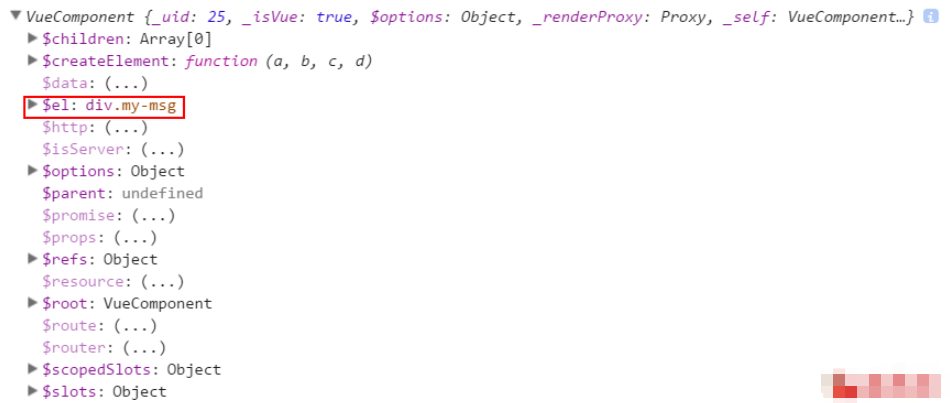本篇内容主要讲解“vue2中如何自定义动态组件”,感兴趣的朋友不妨来看看。本文介绍的方法操作简单快捷,实用性强。下面就让小编来带大家学习“vue2中如何自定义动态组件”吧!
Vue.extend
思路就是拿到组件的构造函数,这样我们就可以new了。而Vue.extend可以做到:https://cn.vuejs.org/v2/api/#Vue-extend
// 创建构造器
var Profile = Vue.extend({
template: '<p>{{firstName}} {{lastName}} aka {{alias}}</p>',
data: function () {
return {
firstName: 'Walter',
lastName: 'White',
alias: 'Heisenberg'
}
}
})
// 创建 Profile 实例,并挂载到一个元素上。
new Profile().$mount('#mount-point')官方提供了这个示例,我们进行一下改造,做一个简单的消息提示框。
动态组件实现
创建一个vue文件。widgets/alert/src/main.vue
<template>
<transition name="el-message-fade">
<div v-show="visible" class="my-msg">{{message}}</div>
</transition>
</template>
<script >
export default{
data(){
return{
message:'',
visible:true
}
},
methods:{
close(){
setTimeout(()=>{
this.visible = false;
},2000)
},
},
mounted() {
this.close();
}
}
</script>这是我们组件的构成。如果是第一节中,我们可以把他放到components对象中就可以用了,但是这儿我们要通过构造函数去创建它。再创建一个widgets/alert/src/main.js
import Vue from 'vue';
let MyMsgConstructor = Vue.extend(require('./main.vue'));
let instance;
var MyMsg=function(msg){
instance= new MyMsgConstructor({
data:{
message:msg
}})
//如果 Vue 实例在实例化时没有收到 el 选项,则它处于“未挂载”状态,没有关联的 DOM 元素。可以使用 vm.$mount() 手动地挂载一个未挂载的实例。
instance.$mount();
document.body.appendChild(instance.$el)
return instance;
}
export default MyMsg;
require('./main.vue')返回的是一个组件初始对象,对应Vue.extend( options )中的options,这个地方等价于下面的代码:
import alert from './main.vue'
let MyMsgConstructor = Vue.extend(alert);而MyMsgConstructor如下。
参考源码中的this._init,会对参数进行合并,再按照生命周期运行:
Vue.prototype._init = function (options) {
...// merge options
if (options && options._isComponent) {
// optimize internal component instantiation
// since dynamic options merging is pretty slow, and none of the
// internal component options needs special treatment.
initInternalComponent(vm, options);
} else {
vm.$options = mergeOptions(
resolveConstructorOptions(vm.constructor),
options || {},
vm
);
}
// expose real self
vm._self = vm;
initLifecycle(vm);
initEvents(vm);
initRender(vm);
callHook(vm, 'beforeCreate');
initInjections(vm); // resolve injections before data/props
initState(vm);
initProvide(vm); // resolve provide after data/props
callHook(vm, 'created');
...
if (vm.$options.el) {
vm.$mount(vm.$options.el);
}
};而调用$mount()是为了获得一个挂载实例。这个示例就是instance.$el。

可以在构造方法中传入el对象(注意上面源码中的mark部分,也是进行了挂载vm.$mount(vm.$options.el),但是如果你没有传入el,new之后不会有$el对象的,就需要手动调用$mount()。这个方法可以直接传入元素id。
instance= new MessageConstructor({
el:".leftlist",
data:{
message:msg
}})这个el不能直接写在vue文件中,会报错。接下来我们可以简单粗暴的将其设置为Vue对象。
调用
在main.js引入我们的组件:
//..
import VueResource from 'vue-resource'
import MyMsg from './widgets/alert/src/main.js';
//..
//Vue.component("MyMsg", MyMsg);
Vue.prototype.$mymsg = MyMsg;然后在页面上测试一下:
<el-button type="primary" @click='test'>主要按钮</el-button>
//..
methods:{
test(){
this.$mymsg("hello vue");
}
}这样就实现了基本的传参。最好是在close方法中移除元素:

close(){
setTimeout(()=>{
this.visible = false;
this.$el.parentNode.removeChild(this.$el);
},2000)
},回调处理
回调和传参大同小异,可以直接在构造函数中传入。先修改下main.vue中的close方法:
export default{
data(){
return{
message:'',
visible:true
}
},
methods:{
close(){
setTimeout(()=>{
this.visible = false;
this.$el.parentNode.removeChild(this.$el);
if (typeof this.onClose === 'function') {
this.onClose(this);
}
},2000)
},
},
mounted() {
this.close();
}
}如果存在onClose方法就执行这个回调。而在初始状态并没有这个方法。然后在main.js中可以传入
var MyMsg=function(msg,callback){
instance= new MyMsgConstructor({
data:{
message:msg
},
methods:{
onClose:callback
}
})这里的参数和原始参数是合并的关系,而不是覆盖。这个时候再调用的地方修改下,就可以执行回调了。
test(){
this.$mymsg("hello vue",()=>{
console.log("closed..")
});
},你可以直接重写close方法,但这样不推荐,因为可能搞乱之前的逻辑且可能存在重复的编码。现在就灵活多了。
统一管理
如果随着自定义动态组件的增加,在main.js中逐个添加就显得很繁琐。所以这里我们可以让widgets提供一个统一的出口,日后也方便复用。在widgets下新建一个index.js
import MyMsg from './alert/src/main.js';
const components = [MyMsg];
let install =function(Vue){
components.map(component => {
Vue.component(component.name, component);
});
Vue.prototype.$mymsg = MyMsg;
}
if (typeof window !== 'undefined' && window.Vue) {
install(window.Vue);
};
export default {
install
}在这里将所有自定义的组件通过Vue.component注册。最后export一个install方法就可以了。因为接下来要使用Vue.use。
安装 Vue.js 插件。如果插件是一个对象,必须提供 install 方法。如果插件是一个函数,它会被作为 install 方法。install 方法将被作为 Vue 的参数调用。
也就是把所有的组件当插件提供:在main.js中加入下面的代码即可。
... import VueResource from 'vue-resource' import Widgets from './Widgets/index.js' ... Vue.use(Widgets)
到此,相信大家对“vue2中如何自定义动态组件”有了更深的了解,不妨来实际操作一番吧!这里是亿速云网站,更多相关内容可以进入相关频道进行查询,关注我们,继续学习!
免责声明:本站发布的内容(图片、视频和文字)以原创、转载和分享为主,文章观点不代表本网站立场,如果涉及侵权请联系站长邮箱:is@yisu.com进行举报,并提供相关证据,一经查实,将立刻删除涉嫌侵权内容。